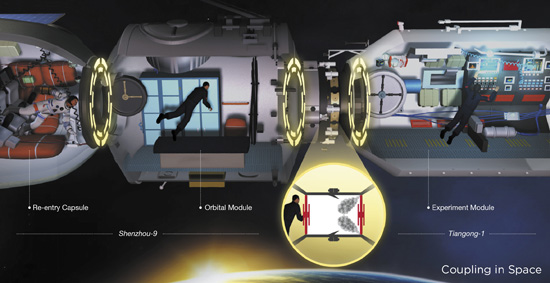|
 |
|
(CFP) |
Tiangong-1 Lab Module
The Tiangong-1 is the rudiment of China's space station and an experimental space laboratory. It is mainly used to carry out the rendezvous and docking test, so as to master the technologies relating to the rendezvous and docking and accumulate the experience for the construction, management and operation of the space station.
The main body of the 8-ton Tiangong-1 is a short and thick cylinder, with a docking port on its front and rear ends. The two modules include an experiment module and a resource module. The experiment module is composed of an enclosed front coneshaped section, a cylindrical section and a rear coneshaped section. On the front end of the experiment module there are the docking mechanism and the measuring and communication equipment, which are used to support the rendezvous and docking with spaceships. The resource module supplies the power necessary for flight.
After Shenzhou-8 and Shenzhou-9, the Tiangong-1 will also conduct with rendezvous and docking tests with the Shenzhou-10 spacecraft within its 2-year designed life span.
(Source: cmse.gov.cn)
Three-Step Space Plan
First: Launching an actual manned spacecraft. (The successful flight by the Shenzhou-5 and Shenzhou-6 spacecraft)
Second: Solving technical difficulties of docking two spaceships together. (The launch of the Shenzhou-7 spacecraft, the Tiangong-1 space lab module and the spacecraft Shenzhou-8, Shenzhou-9 and Shenzhou-10)
Third: Building Tiangong-2 and Tiangong-3 space laboratories in 2013-16 to conduct even more advanced research.
(Source: cntv.cn)
Manned Space Program
September 21, 1992: China's manned spaceflight program was officially approved.
November 20, 1999: The unmanned Shenzhou-1 spacecraft was launched for a test flight.
January 10, 2001: The unmanned Shenzhou-2 entered space, carrying animals.
March 25, 2002: The unmanned Shenzhou-3 spacecraft lifted off, carrying a test dummy.
December 30, 2002: The unmanned Shenzhou-4 spacecraft was launched, carrying a test dummy and several science experiments.
October 15, 2003: The Shenzhou-5 spacecraft blasted off into space with Yang Liwei, the first Chinese astronaut, on board.
October 12, 2005: The Shenzhou-6 spacecraft was launched, sending two astronauts, Fei Junlong and Nie Haisheng, into space.
September 25, 2008: The Shenzhou-7 spaceflight mission sent Zhai Zhigang, Liu Boming and Jing Haipeng into space. Zhai completed China's first space walk on September 27, 2008.
September 29, 2011: China's first unmanned space lab module, the Tiangong-1, or Heavenly Palace-1, was launched.
November 1, 2011: The unmanned Shenzhou-8 spacecraft was launched. Two days later, it successfully docked with the Tiangong-1.
June 16, 2012: The manned Shenzhou-9 spacecraft blasted off and made a successful automated docking with the Tiangong-1 two days later.
(Source: Xinhua News Agency)
Email us at: yinpumin@bjreview.com | 